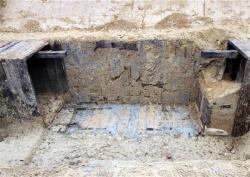11 NOVEMBRE
INDI-UNI : ANTHROPOLOGY - ARCHAEOLOGY
INSCRIPTION 2011 – 2012 COURS A DISTANCE
REGISTRATION 2011 – 2012 ONLINE COURSES
FRANCE –  Carspach - Deux mois après son lancement, le chantier de fouilles archéologiques du « Kilianstollen » qui ont permis de retrouver les 21 soldats allemands tués en 1918, s’est achevé hier à Carspach. Lancé le 13 septembre dernier à la suite de la découverte d’un abri allemand datant de la Première Guerre mondiale sur le tracé du chantier du contournement d’Aspach, le chantier de fouilles, qui a permis d’exhumer les restes des 21 soldats allemands morts à cet endroit en 1918, s’achève. Du moins pour l’essentiel. « On va revenir démonter encore quelques petites choses et prendre encore des mesures mais le gros du chantier est terminé », confirme Mickaël Landolt, responsable des fouilles. Outre les 21 corps des soldats retrouvés qui feront l’objet d’une étude anthropologique avant d’être restitué au service des sépultures allemandes qui se chargera d’entrer en contact avec les familles, le millier d’objets de la vie quotidienne (livres, pipes, lunettes, dés, jeux, etc.) retrouvé dans l’abri a été ramené à Sélestat et devraient, à terme, être exposés au public. Tout comme une partie de l’abri allemand que les archéologues se sont attelé à démonter ces derniers jours. Trois mètres de galerie soigneusement nettoyés, étiquetés et emballés qui, après avoir été entreposés temporairement dans un local mis à disposition par la commune de Carspach, seront acheminés dans locaux du Pair en attendant qu’un laboratoire soit désigné pour la restaurer. Des travaux dont le coût est pris en charge par le Conseil général du Haut-Rhin. Une fois restauré, l’abri sera lui aussi exposé à la vue du grand public, dans un lieu qu’il reste encore à déterminer.
Carspach - Deux mois après son lancement, le chantier de fouilles archéologiques du « Kilianstollen » qui ont permis de retrouver les 21 soldats allemands tués en 1918, s’est achevé hier à Carspach. Lancé le 13 septembre dernier à la suite de la découverte d’un abri allemand datant de la Première Guerre mondiale sur le tracé du chantier du contournement d’Aspach, le chantier de fouilles, qui a permis d’exhumer les restes des 21 soldats allemands morts à cet endroit en 1918, s’achève. Du moins pour l’essentiel. « On va revenir démonter encore quelques petites choses et prendre encore des mesures mais le gros du chantier est terminé », confirme Mickaël Landolt, responsable des fouilles. Outre les 21 corps des soldats retrouvés qui feront l’objet d’une étude anthropologique avant d’être restitué au service des sépultures allemandes qui se chargera d’entrer en contact avec les familles, le millier d’objets de la vie quotidienne (livres, pipes, lunettes, dés, jeux, etc.) retrouvé dans l’abri a été ramené à Sélestat et devraient, à terme, être exposés au public. Tout comme une partie de l’abri allemand que les archéologues se sont attelé à démonter ces derniers jours. Trois mètres de galerie soigneusement nettoyés, étiquetés et emballés qui, après avoir été entreposés temporairement dans un local mis à disposition par la commune de Carspach, seront acheminés dans locaux du Pair en attendant qu’un laboratoire soit désigné pour la restaurer. Des travaux dont le coût est pris en charge par le Conseil général du Haut-Rhin. Une fois restauré, l’abri sera lui aussi exposé à la vue du grand public, dans un lieu qu’il reste encore à déterminer.
http://www.lalsace.fr/haut-rhin/2011/11/11/la-fin-du-chantier-de-fouilles-du-kilianstollen?image=A053AE1B-84A9-41A0-B60B-FAF8FAFF4139
PEROU – Nazca - A Peruvian farmer faced fines after digging a well in the middle of the Nasca archeological site. Nasca's giant tracings of lines and animal figures in Peru's southern Ica desert are one of the world's great archeological mysteries. They can only be fully seen from the air, though the ancient drawings date to the fifth or sixth century BC, more than two millennia before human flight. Three geometric lines were damaged in the 'campos barridos,' or 'swept fields,' section of the site. The farmer, who owns land nearby, drove his tractor past warning signs. Nasca is a UNESCO world cultural heritage site.
http://www.monstersandcritics.com/science/news/article_1674403.php/Farmer-damages-giant-drawings-at-Peru-s-Nasca-archeological-site
USA – Fort Lane – Built by the U.S. Army's First Dragoons based in Benicia, Calif., the fort represented the Rogue Valley's only civil authority in the early 1850s. Established shortly after a clash between American Indians and Euro-American settlers, it was named in honor of Joseph Lane, Oregon's first territorial governor. Lane also led military campaigns against local American Indians in 1851 and 1853. Shaped like a giant horseshoe, the original fort had more than a dozen buildings, including infantry quarters, officers' quarters, kitchens, a small medical building, guard house, blacksmith shop and store. However, aside from a few large foundation stones, nothing remains above ground now, save for the stone monument just east of the site built by the Daughters of the American Revolution in 1929. Stones to build the monument were taken from fireplaces at the fort, Tveskov noted. "When the fort was abandoned, it fell down in place and rotted away," he said of the wooden structures. "There were some squatters here in the late 1800s." Five years ago a research team led by Tveskov and Rose mapped out where the buildings were in the old fort. "We matched the archaeology on the ground to the plans we had of the fort," he said. "We catalogued the looting that had occurred out here. We got a sense of its integrity and research potential." The fort provides a rare snapshot in time of the clash between the two cultures, Rose said.
http://www.mailtribune.com/apps/pbcs.dll/article?AID=/20111111/NEWS/111110337
THAILANDE –  Wat Mahathat - Une tête de Bouddha entremêlée dans un tronc d’arbre est partiellement submergée par les eaux dans les ruines du temple de Wat Mahathat en Thaïlande, dans l’ancienne capitale de Ayutthaya, le 6 novembre 2011. Reuters/Adrees Latif.
Wat Mahathat - Une tête de Bouddha entremêlée dans un tronc d’arbre est partiellement submergée par les eaux dans les ruines du temple de Wat Mahathat en Thaïlande, dans l’ancienne capitale de Ayutthaya, le 6 novembre 2011. Reuters/Adrees Latif.
USA – Jacksonville - National Park Service officials and a University of Florida archaeologist announced Thursday the discovery of six graves at Kingsley Plantation that seem to date to the early 1800s, the time when plantation owner Zephaniah Kingsley and his African-born wife, Anna Madgigine Jai, once a slave, ran a cotton plantation from 1814 to 1837. The adults were almost certainly born in West Africa and taken into slavery, Davidson said. The graves were grouped together perhaps 50 or 60 yards north of the tabby remains of a row of slave quarters on the east side of Palmetto Avenue, the dirt road that leads to the plantation house. There’s currently nothing to mark the site: The skeletons were left undisturbed and other items in the graves, such as nails and buttons, were placed back where they were found.
http://m.jacksonville.com/news/metro/2011-11-10/story/uf-archaeological-team-finds-six-human-burials-kingsley-plantation